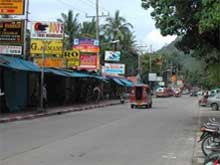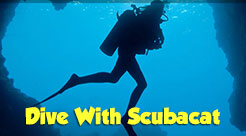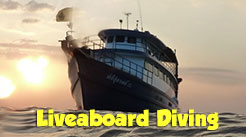Phuket, Thailand
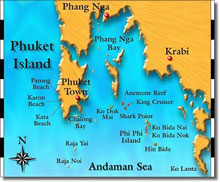
Access to Phuket Thailand is easy with multiple flights daily from Bangkok, Singapore, Kuala Lumpur and Hong Kong. We recommend that you arrive a few days before you join us and stay at one of Phuket's many excellent hotels. This will give you time to become acclimatized, do some shopping, or check out your dive equipment before joining us for some Day Trips, Liveaboards or a Diving Course. Formerly known as Tha-Laang or Talang is one of the southern provinces (changwat) of Thailand. Neighbouring provinces are (from north clockwise) Phang Nga and Krabi, but as Phuket is an island there are no land boundaries.
The island is served by Phuket International Airport, located in the north of the island. The ph of "Phuket" is an aspirated hard "p", not a soft "f", so the name is pronounced (roughly) "Poo-get". The name Phuket is apparently derived from the word Bukit in Malay, which means mountain or hill, as this is what the island appears like from a distance.
Scuba Cat Diving, Phuket, is known worldwide for training quality and customer services having an excellent reputation within the diving industry for producing first class and highly employable PADI Instructors from their PADI IDC's. Scuba Cat Diving, Phuket, Thailand is the only PADI 5 Star CDC Center based on Patong Beach, this is the highest PADI Dive Center achievement possible. PADI CDC distinguishes us from the rest.
Before that its old name was Ta-lang (in Thai): The word is derived from the old Malay "Telong" which means "Cape", is still in use for one of the main districts in the Phuket area.
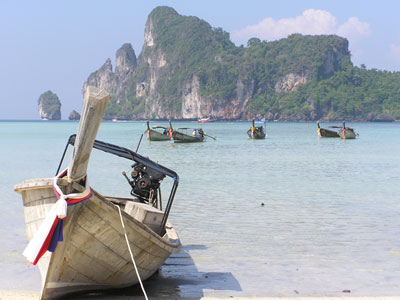
Geography
Phuket is the biggest island in Thailand, located in the Andaman Sea in southern Thailand. The island is mostly mountainous with a mountain range in the west of the island from the north to the south. The mountains of Phuket form the southern end of the Phuket mountain range, which ranges for 440 km from the Kra Isthmus. The highest elevation of the island is Mai Thao Sip Song (Twelve Canes). At 529 m above sea level 70% of the island is covered by forest. The western coast has several sandy beaches, while on the east coast beaches are more often muddy. Near the southernmost point is Laem Promthep (Brahma's Cape), which is a popular sunset viewing point.
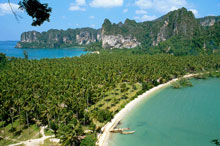
In the mountainous north of the island is the Khao Phra Thaeo Wildlife Sanctuary, protects more than 20 kmē of rainforest. The three highest peaks of this reserve are the Khao Prathiu (384 m), Khao Bang Pae (388 m) and Khao Phara (422 m). The Sirinat National Park on the northwestern coast was established in 1981 and protects an area of 90 kmē (68 kmē marine area), including the Nai Yang beach, where sea turtles lay their eggs.
One of the most popular tourist areas on Phuket is Patong Beach on the central western coastdue to easy accessibility to its wide and long beach. Most of Phuket 's nightlife and its cheap shopping is located in Patong and the area has become increasingly developed. Patong means "the forest filled with banana leaves" in Thai.
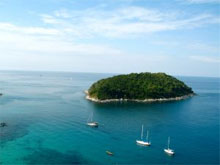
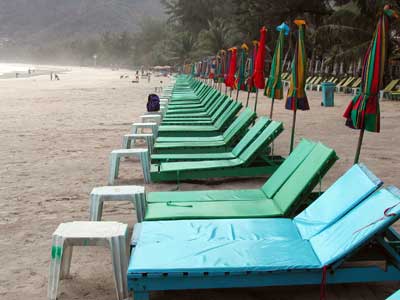
Other popular beaches are located south of Patong. In a counterclockwise direction these include Karon Beach, Kata Beach, Kata Noi Beach and around the southern tip of the island, Nai Harn Beach. These areas are generally much less developed than Patong and sought out by individuals, families and other groups with a preference for more relaxed and less crowded environs than Patong. See our full list of Phuket's beaches.
Phuket Hotels
Phuket boast international luxury standard hotels such as Le Meridien, Evason and Amanpuri, but also have a huge range of cheaper hotels for all kinds of budgets.
Phuket Villa Rental
Looking for Phuket villa rentals? Renting a house or apartment in Phuket is relatively simple and trouble free. Even if you are a tourist, you may find it makes more sense both financially and practically to rent a place short-term as opposed to staying in a hotel. As you might expect, there is a diverse range of property available to rent in Phuket from small studio apartments from 250 USD month to luxurious seaside villas at 2,000 USD day.
Economy
Tin mining has been a major source of income for the Island since the 16th century. Chinese businessmen and Chinese workers were employed in the mines. Most were Hakka Chinese, and their influence on Phuket culture and cuisine can still be felt today. With falling tin prices, the mining has now all but ceased. Nowadays, Phuket 's economy rests on two pillars rubber tree plantations (making Thailand the biggest producer of rubber in the world) and tourism.
Since the 1980s Phuket has become one of the major tourist attractions of Thailand and most of the sandy beaches on the western coast of the Island have been heavily developed into tourist centers, with Patong, Karon and Kata being the most popular ones. Along with its stunning beaches and picture-perfect landscape, the increase in tourists has been amazing. Since the 2004 Tsunami, all damaged buildings and attractions have been restored.
History
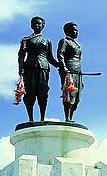
The most significant event in the history of Phuket was the attack by the Burmese in 1785. Sir Francis Light, a British East India Company Captain passing by the island sent word to the local administration that he had observed Burmese forces preparing to attack. Kunying Jan, the wife of the recently deceased governor and her sister Mook then assembled what forces they could. After a month-long siege, the Burmese were forced to retreat March 13, 1785. The two women became local heroines, receiving the honorary titles Thao Thep Kasatri and Thao Sri Sunthon from King Rama I.
During the reign of King Chulalongkorn (Rama V), Phuket became the administrative center of the tin-producing southern provinces. In 1933 Monthon Phuket was dissolved and Phuket became a province by itself.
On December 26, 2004, Phuket and other nearby areas on Thailand's western coast suffered extensive damage when they were struck by a tsunami caused by the 2004 Indian Ocean earthquake. The waves destroyed several highly populated areas in the region, killing as many as 5,300 people nationwide and tens of thousands more throughout the wider Asian region. As many as 250 people were reported dead in Phuket including foreign tourists. ITN journalist John Irvine and his family survived the tsunami, despite being washed 50m inland. Almost all the major beaches on the west coast, especially Patong, Karon and Kata sustained major damage, with some damage also being caused to resorts and villages on the island's southern beaches.
However, by February 2005 most undamaged resorts were back in business and throughout 2005 life slowly returned to normal for the people of Phuket. As of November 2005, following strenuous recovery programmes, there is little obvious tsunami damage remaining other than at more remote beaches and the tourist industry, which drives the Phuket economy appears to have almost fully recovered.
Demographics
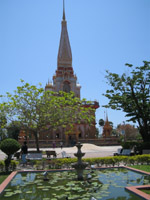
As with most of Thailand, the majority of the population is Buddhist. There is a significant number of Muslims (30%) in Phuket, mainly descendants of the island's original sea-dwelling people.
Administrative Divisions
Phuket is divided into 3 districts (Amphoe), which are further subdivided into 17 communes (tambon) and 103 villages (muban). There is also one city (thesaban nakhon) - Phuket, one town (thesaban mueang) and 4 townships (thesaban tambon), and also 13 tambon administrative organizations (TAO).
- Mueang Phuket
- Kathu
- Thalang
Thai Food
If you love food, you will love Phuket, Thailand. There are restaurants to suit every taste serving a huge selection of Western and Asian food. The variety of cuisine and dining experiences is one of the major attractions of the island. You can eat breakfast at your Phuket hotel, lunch at a local noodle stall by the roadside and have dinner with fine wines in a sophisticated air-conditioned restaurant.
Fancy a snack in between? No need for thai food delivery - One of the wonderful characteristics of Thailand is the reverence for food and eating, so you can eat at almost any time of the day, anywhere. Tropical fruit, banana fritters, barbecue chicken and sticky rice? It's all here... While Thai food is renowned world-wide for its wonderful flavours and fresh ingredients, Phuket Thailand is especially famous for its seafood and you don't have to empty your bank account to enjoy the most sumptuous of dishes.
Read more about thai dishes.
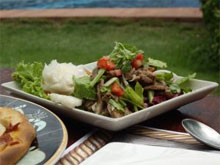
Phuket Island Information
Phuket, Thailand; formerly known as Tha-Laang or Talang is one of the southern provinces (changwat) of Thailand. Neighbouring provinces are (from north clockwise) Phang Nga and Krabi, but as Phuket is an island there are no land boundaries. The island is served by Phuket International Airport located in the north of the island. The ph of "Phuket" is an aspirated hard "p", not a soft "f", so the name is pronounced (roughly) "Poo-get". The name Phuket is apparently derived from the word Bukit in Malay, which means mountain or hill, as this is what the island appears like from a distance.
Before that its old name was Ta-lang (in Thai): The word is derived from the old Malay "Telong" which means "Cape", which is still in used for one of the main districts in the Phuket area.
Phukets Beaches
Phuket is a large island with a wide choice of beaches to suit every taste and requirement. Most of the beaches are located on the west coast of the Island. The quieter beaches tend to be found towards the Island's northwestern coastline, while the greatest concentration of hotels, shops and restaurants are located around Patong Beach and stretches south towards Karon Beach and Kata Beach.
More information on Phuket's beaches.
Sirinat National Park
In 1980 Mr Sanae Wattanathorn the governor of Phuket surveyed the province to identify sites worthy of preservation. He considered both the tourist potential and the local villagers needs at all sites. One location visited was at Saku village on the North Western coast of Phuket island, centered upon an area of community grazing land and adjoining beach and bay.
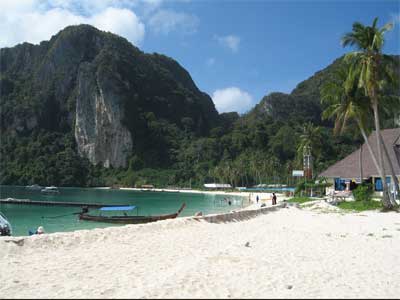
This site appeared to be suitable for preservation, so it was recommended to the Royal Forest Department as a possible site for the creation of a National Park. The Royal Forest Department came and undertook several surveys to assess the site's potential. They realized, that although the forest in the area was not especially diverse and in some areas had been replaced by fruit tree plantations, they did discover two large healthy coral reefs in the bay. They also noted the overall natural state of the site the clean water and its historic importance as a sea turtle nesting beach. The Royal Forest Department produced and filed a report with the government for the inclusion of the site as a National Park. Had Nai Yang, as the site became known, was officially opened by Royal decree on 13th July 1981. It became the 31st National Park of Thailand and covered the area of coastline and extended 5 kms out to sea.
Find out more about Sirinat National Park.
Phuket City
Phuket City is well worth taking time out from the beach for its shops and markets, Sino-Portuguese buildings, temples and many restaurants.
The bustling, administrative centre of Phuket is often overlooked in favour of the beaches, but there's a lot to see and do in Phuket City. Phuket's administrative centre was only recently given city status and is still commonly referred to as Phuket Town, even on road signs. As a living, breathing Thai city, it is not specifically tailored to tourists as other areas of the Island. However, if you are willing to make the effort there are some delightful ways to spend your time.
Find more information on Phuket City.
